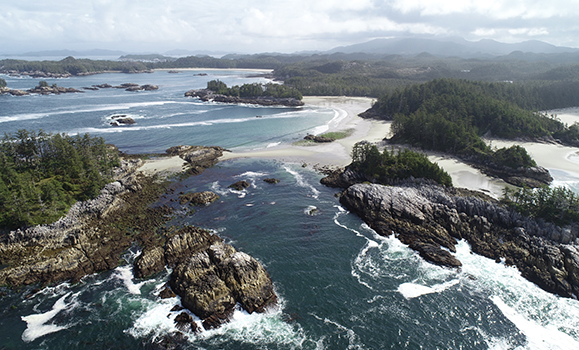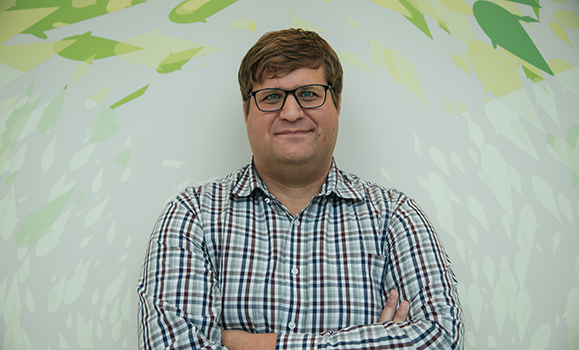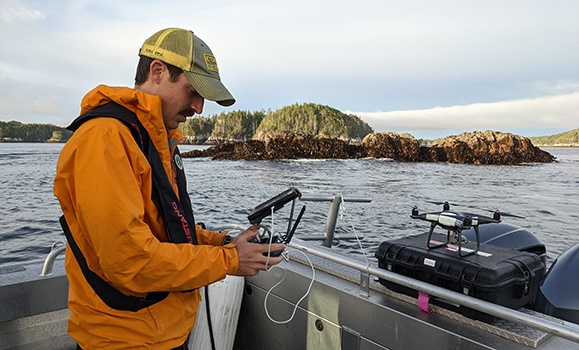The Snapshot
Backed by a $2.5-million grant from Canada’s Ocean Supercluster, the Building Bridges research project, led by Dalhousie, is hardwiring the AI revolution and the ocean sector by empowering researchers and industry with new digital tools to gather, analyze and share data.
The Challenge
Traditionally, when ocean researchers want to study how mussel populations change over time it involves hip waders and slogging through tidal waters, counting molluscs and jotting notes — again and again, rain or shine. It’s difficult and time-consuming work, but the insights the data provide make it invaluable.
A barometer of ocean health, changes in how these super sensitive shellfish gather on rocks provide important information about their evolving ecosystems and the impacts of climate change. It can also help Canadian mussel farmers, who produced over 20,000 tonnes of the shellfish each year, to understand how best to build the industry on the country’s coasts.

“We have an intertidal mapping program where researchers are out in the field, they're measuring, they're counting, they're kneeling down and looking at individual pieces. But they can only get to so many places, it's dangerous. We're out on the West Coast with steep rocky shores. And some of the places we can't even get to,” says Will McInnes, a Geographic Information System specialist at British Columbia-based Hakai Institute.
Hakai is one of Dalhousie’s six ocean research partners in the Building Bridges research project. Led by Dal and supported by a $2.5-million grant from Canada’s Ocean Supercluster, the endeavour aims to maximize the impact of ocean research with artificial intelligence (AI).
Dal data scientist Dr. Mike Smit, the project's principal investigator, emphasizes the urgent need for AI to empower ocean researchers in their fieldwork and to ensure the data they gather has as much impact as possible.

Dal’s Dr. Mike Smit leads the Building Bridges project. (Cody Turner photo)
“Every piece of data has potential value to us. If that data sits locked in a desk drawer, filing cabinet or hard drive, it’s not bringing benefits to Canadians that it should be. AI can ease the data gathering process and dramatically increase our ability to share, analyse and learn from it,” he says.
The Solution
Ushering the AI revolution into Canada’s ocean economy will require a new generation of professionals who understand the fast-evolving digital tools and how they can be applied to better understand the waters that surround us, says Dr. Smit.
“We've seen time and time again, when we want to roll AI out across different sectors that leaders say, ‘We don't even know what's possible in the space. We can hire the technical expertise, but we don’t know what we want them to do. Building Bridges will help ocean people understand enough about AI to know what it can do, and tech people enough about oceans to be able to do it,” he says.
The project will support innovators in the field like Hakai to develop and share their AI research methods for others to learn from. It will also strengthen Canada’s ocean data management by enhancing the work of the Canadian Integrated Ocean Observing System (CIOOS), the country’s central repository for ocean data gathered by government, academia, industry, NGOs, Indigenous communities and others. CIOOS, which receives its primary funding from Fisheries and Oceans Canada and MEOPAR, will leverage AI to ease data submission processes and ensure it’s available and accessible to everyone that can use it.
“We need to harness what AI is really good at to manage Canada’s ocean data and ensure it’s available and accessible for people who do research to help us better understand the ocean and people in industry interested in commercial applications. All of those conversations are informed by broader access to data,” says Dr. Smit.
The Work
Swooping along British Columbia’s rugged coastline, Hakai Institute drones have become a frequent sight above the province’s mussel fields. The images they capture are fed into an AI program that helps their scientists to better understand the bivalves, without anyone getting their feet wet.
“It's pretty amazing. On the same day we can go out there with a drone and then stick the images together into a map, feed it into the AI, and at the end, you get images that cover large areas,” says McInnes. “We can use the AI to identify how many there are and how things are changing over time, like whether they’re moving up and down, based on changes in temperature, high heat, freezing events, influence from sea stars, or whatever else might affect them.”
Hakai Institute drone makes its way along the coast of B.C. (Hakai Institute)
Hakai’s mussel-observation project is just one of several taking place as part of Building Bridges. Smit says others will further demonstrate how researchers can deploy AI to eliminate manual and administrative tasks to focus on answering core questions.
He describes another project focused on ocean acoustics: “The researchers put hydrophones in the water, and record sound for days, weeks, months. There is a lot to listen to. That’s really labor intensive,” says Dr. Smit. “Rather than a human listening, a computer can automatically identify noises like whale sounds or ship noise to study how ship traffic is impacting whales.”
The Impact
Dr. Smit says that the ambition of Building Bridges aligns with Canada’s Pan-Canadian Artificial Intelligence Strategy(PCAIS), which identifies the need to capitalize on the country’s competitive advantage in AI research capacity and talent. To that end, the project is funded by Ocean Supercluster through an allocation through the PCAIS program.
Dr. Smit discusses the ambitions of the project and its goals.
“If we’re going to maximize the opportunity, we need all sectors of the economy to be doing the adopting, developing, mobilizing and commercializing here in Canada,” says Dr. Smit. “As Canada’s ocean research leader and home to the Atlantic headquarters of CIOOS, Dalhousie is ideally placed to help lead the effort.”
Will McInnes says Hakai’s project is helping their researchers get new insight into the behaviour of mussels. He notes, for example, that they will be able to study how temperature spikes like recent heat domes kill off mussels and other sea life in intertidal waters.
“We’ll be able to better understand these dynamics, as well as changing ocean temperatures and acidification,” he says.
As Hakai learn from their data, CIOOS is developing new AI models to ensure it is also captured and made easily available to other scientists and industry partners. And, just as importantly, Hakai’s research methods will provide a model for other researchers, helping to inform best practice for integrating AI into their work.
“Part of our goal for this project is to make our AI tools freely available, as well as the source data and code so that others can use it, modify it and take it their own way.”

